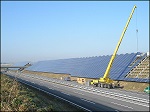How solar energy could be the largest source of electricity by mid-century
The sun could be the world’s  largest source of electricity by 2050, ahead of fossil fuels, wind, hydro and nuclear, according to a pair of reports issued today by the International Energy Agency (IEA). The two IEA technology roadmaps show how solar photovoltaic (PV) systems could generate up to 16% of the world’s electricity by 2050 while solar thermal electricity (STE) from concentrating solar power (CSP) plants could provide an additional 11%. Combined, these solar technologies could prevent the emission of more than 6 billion tonnes of carbon dioxide per year by 2050 – that is more than all current energy-related CO2 emissions from the United States or almost all of the direct emissions from the transport sector worldwide today.
largest source of electricity by 2050, ahead of fossil fuels, wind, hydro and nuclear, according to a pair of reports issued today by the International Energy Agency (IEA). The two IEA technology roadmaps show how solar photovoltaic (PV) systems could generate up to 16% of the world’s electricity by 2050 while solar thermal electricity (STE) from concentrating solar power (CSP) plants could provide an additional 11%. Combined, these solar technologies could prevent the emission of more than 6 billion tonnes of carbon dioxide per year by 2050 – that is more than all current energy-related CO2 emissions from the United States or almost all of the direct emissions from the transport sector worldwide today.
The two documents underline the complementary role of the two technologies. With 137 GW of capacity installed worldwide at the end of 2013 and adding up to 100 MW each day, PV deployment so far has been much faster than that of STE, mainly thanks to massive cost reductions. Under the scenario described in the roadmaps, most of the growth of solar electricity comes from PV until 2030. However, the picture changes afterwards. When reaching shares between 5% and 15% of annual electricity generation, PV starts to lose value in wholesale markets. Massive-scale STE deployment takes off at this stage thanks to CSP plants’ built-in thermal storage, which allows for generation of electricity when demand peaks in late afternoon and in the evening, thus complementing PV generation.
PV expands globally, with China being by far the leading country, followed by the United States. Over half of total capacity is situated at the final consumers’ place – whether households, shopping malls or industries. STE expands in very sunny areas with clear skies, becoming a major opportunity for Africa, India, the Middle East and the United States
read the whole IEA report at www.iea.org
Image credit Wikimedia Commons
(pp)




